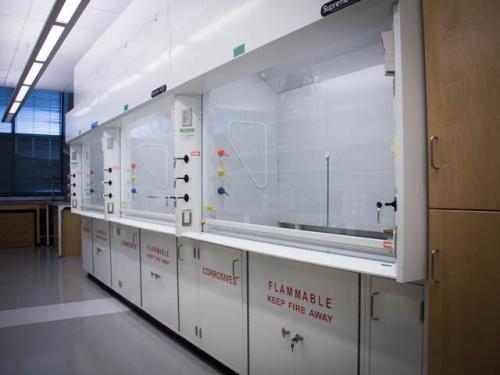Fume hoods are a primary method of exposure control in the laboratory. A fume hood is a ventilated enclosure that usually vents separately from the building’s heating, ventilation and air conditioning (HVAC) system and not recirculated into the building. Fume hoods should be used when working with toxic compounds or compounds with a boiling point below 120°C. Fume hoods, or other effective local ventilation, must be provided and used when the materials used will exceed exposure limits in the laboratory.
Standards for determining permissible exposure limits include:
- Occupational Safety and Health Administration Permissible Exposure Limits (OSHA PELs)
- National Institute for Occupational Safety and Health Recommended Exposure Limits (NIOSH RELs)
- American Conference of Governmental Industrial Hygienists threshold limit values (ACGIH TLVs®)
- American Industrial Hygiene Association Workplace Environmental Exposure Limits (AIHA WEELs)
Types of fume hoods
Types of fume hoods at the University include chemical, radioisotope and perchloric acid hoods, with various airflow controls. Fume hood controls include constant air volume (CAV), variable air volume (VAV) and two-state (two speed) control. A number of older wood fume hoods and fume “cupboards” are still maintained. The hoods will display a label that identifies what type of ventilation control is employed:
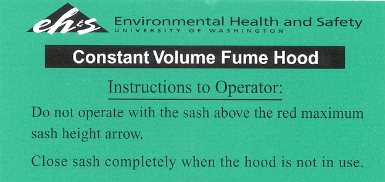 | 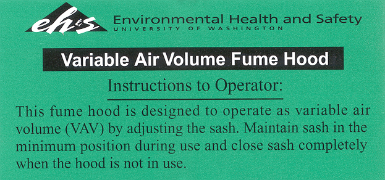 | 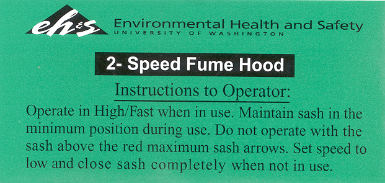 |
Fume hoods are categorized into one of two groups: 1) standard flow, and 2) low flow. Standard flow fume hoods are designed to operate at 100 linear feet per minute (LFM) at 18 inches sash height. (Note that some legacy hoods were designed to operate at 100 LFM at full sash height, as high as 25 inches). Low flow fume hoods are designed to operate at 70 LFM at 18 inches sash height.
How to use a fume hood
The fume hood can provide adequate protection for most laboratory processes if it is used correctly.
The fume hood must be operated with the sash no higher than the red arrow.

Detailed instructions for use of the fume hood can be found in the Lab Safety Manual.
Fume hood testing and inspection
EH&S performs a functional performance test to assure hoods perform as required about every 18 months. The performance test typically includes an evaluation of the face velocity, the sound, containment, monitor performance and the tracking ability of a VAV (when applicable). EH&S may also note any observed problem with controls, sash, baffles, plumbing, light or corrosion.
Fume hoods tested by EH&S will have a label that records its inspection history:
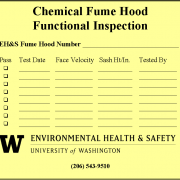
The following definitions are used by EH&S to track the operational status of fume hoods.
If a hood fails an inspection, it may need to be taken out of service until repaired. EH&S will notify the researchers and post a “Do Not Use” sign if repair is required. When UW Facilities has completed repairs, EH&S will retest the hood and put it back in service.
What you need to know
Use your fume hood, or other engineering controls, rather than the benchtop when there is a possibility of overexposure to air contaminants generated by a laboratory activity.
In the event of lab move out and some services/repairs, lab personnel and researchers are responsible for decontamination of their fume hoods. Complete and post this form when performing fume hood decontamination (UW Form 1803: Notice of Laboratory Equipment Decontamination).
Be aware of ventilation system shutdowns and do not use the hood when the ventilation system serving the room is shut down.
Fume hood alarms
Most fume hoods are equipped with monitors that will generate an audible and, in some cases, a visible alarm when the airflow drops to approximately 80% of the design velocity. The following guidelines should be followed if your alarm activates:
- Be certain you are operating the hood at or below the sash arrows. If the alarm persists, close the sash and wait a moment and then reopen the sash to your working height.
- If the alarm continues, stop using the hood, close the sash and contact EH&S.
Services available
- Routine performance testing in accordance with ANSI Z9.5
- Commission new hoods following procurement and associated with new construction and renovation
- Consult on setup and use of fume hoods
- Troubleshoot fumehood performance issues with UW Facilities
- Perform design review for new and renovated facilities
- Maintain a list of approved fumehoods for UW procurement and use
If you are having problems with your fume hood, contact EH&S at 206.543.9510. We will troubleshoot the problem and we may refer it to UW Facilities for repair.
Repair and maintenance of the hoods is performed by UW Facilities.
Purchasing a fume hood
EH&S is required to help assure that the appropriate hood is selected and that the building's infrastructure can support the installation. Installing and replacing a fume hood may require design and planning, asbestos abatement, decontamination and work beyond simply installing the hood. An evaluation by a mechanical engineer (or other qualified party) and a design is often needed before procurement is authorized.
Hoods must be selected from the approved list below:
| Manufacturer | Conventional Flow Face Velocity (100 fpm) | Low Flow Face Velocity (70 fpm |
|---|---|---|
KEWAUNEE SCIENTIFIC CORP | Supreme Air® | Supreme Air VENTURI® |
LABCONCO | “Protector” models | XStream® |
MOTT MANUFACTURING | Sigma Pro® | SafeguardTM |
If you have any questions about selecting or purchasing a fume hood, please contact the Biosafety Cabinet Program.
Design information
EH&S design guides and specifications are found on the Facilities Project Support page.
Frequently asked questions
Procedures using concentrated perchloric acid (>70%) or heat any amount or concentration of perchloric acid must be performed in a closed system or within a specially designed perchloric acid fume hood with wash down systems to prevent the accumulation of explosive perchlorates in the hood and ducting. Perchloric acid hoods shall be prominently labeled “Perchloric Acid Hood.”
For assistance in purchasing or locating a perchloric acid fume hood, contact EH&S.
Laboratories can experience ventilation shutdowns. These shutdowns can be the result of planned maintenance work as well as unplanned events such as equipment failure or power outages.
Do not use fume hoods when the ventilation system serving a room is not functioning. This applies to both supply air as well as exhaust air. Inadequate ventilation associated directly with your equipment or indirectly with your room can compromise personal protection.
If you have concerns regarding your fume hood during a shutdown or need help troubleshooting issues with your equipment, contact Environmental Health & Safety at 206.543.9510.
More Information
SEFA 9- 2010
ANSI/AIHA Z9.5 “ ANSI Standard for Laboratory Ventilation,”
ASHRAE 110-1995 “Method of Testing Performance of Laboratory Fume Hoods.”
